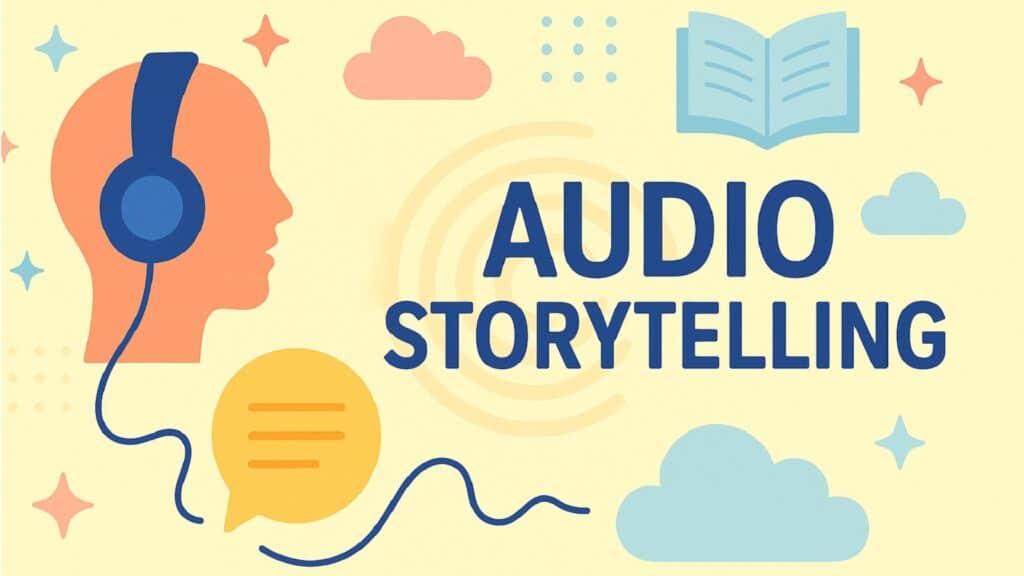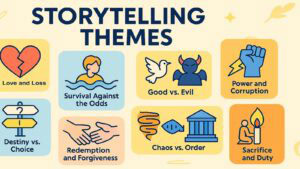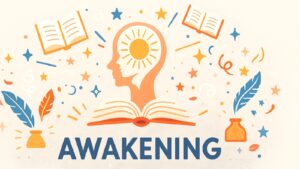Table of Contents
Introduction: The Imaginative Power of Audio Storytelling
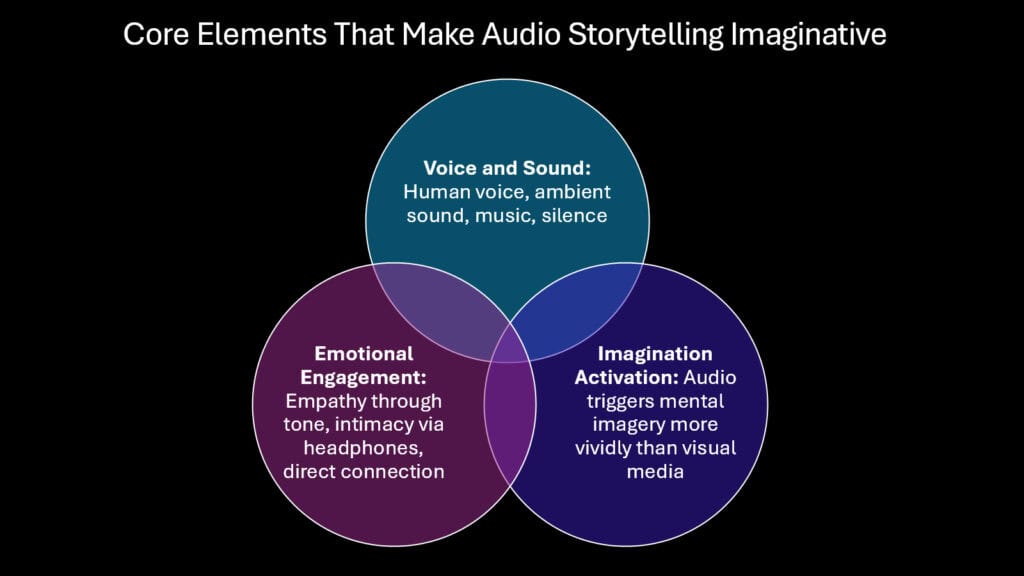
Long before the written word existed, humans gathered around fires to share stories through voice alone. Audio storytelling represents one of the most ancient and enduring storytelling formats, tracing its roots back to oral traditions that preserved cultural memory across generations. Modern technology has transformed this primal art form, enriching it with sophisticated production techniques, immersive soundscapes, and global distribution platforms that reach millions of listeners worldwide.
Audio storytelling transcends simple narration. It creates a unique imaginative space where listeners become active participants in constructing meaning, visualizing characters, and building entire worlds within their minds. Unlike visual media that presents predetermined images, audio storytelling invites the imagination to fill gaps, interpret nuances, and personalize the narrative experience.
When compared to other storytelling formats, audio storytelling occupies a distinctive position. Oral storytelling relies on immediate presence and audience interaction, while digital storytelling often combines multiple media elements. Poetry emphasizes linguistic beauty and condensed meaning, whereas graphic narratives depend on visual-textual synergy. Dramatic scripts require physical performance and staging. Audio storytelling, however, harnesses the pure power of voice, sound, and silence to create immersive experiences that exist entirely within the listener’s mental landscape.
This exploration reveals six incredible ways audio storytelling fuels imagination: through reader-response engagement, emotional vocal expression, cognitive mental mapping, sonic worldbuilding, fragmented narrative structures, and intimate personal connection. Each approach demonstrates how audio storytelling uniquely ignites human creativity and imaginative participation.
Table 1: Comparison of Storytelling Formats and Their Imaginative Impact: Audio Storytelling and Other Storytelling Formats
| Storytelling Format | Primary Medium | Imaginative Engagement | Accessibility |
|---|---|---|---|
| Audio Storytelling | Voice and Sound | High mental visualization | Portable and multitasking-friendly |
| Oral Storytelling | Live voice and gesture | Interactive and immediate | Location and time dependent |
| Digital Storytelling | Multiple media elements | Guided visual experience | Technology dependent |
| Poetry | Written/spoken language | Metaphorical interpretation | Requires literary familiarity |
| Graphic Narratives | Visual and textual | Sequential visual processing | Visual literacy required |
| Dramatic Scripts | Performance and staging | Environmental immersion | Venue and production dependent |
1. Audio Storytelling and the Unseen World of the Mind
Reader-response theory illuminates how audio storytelling transforms listeners into active meaning-makers rather than passive consumers. Wolfgang Iser and Louise Rosenblatt pioneered this framework, emphasizing how readers bring their personal experiences, cultural backgrounds, and emotional states to interpret any text. In audio storytelling, this process becomes intensely personal and immediate.
When listeners encounter an audio narrative, they draw upon their internal repository of memories, associations, and sensory experiences to construct the story world. A narrator describing a childhood home triggers different mental images for each listener based on their own lived experiences. The absence of predetermined visuals means every listener creates a unique version of the narrative, making each listening experience profoundly individual.
Audio storytelling leverages this co-creative process through deliberate gaps and ambiguities. Skilled audio storytellers understand that what remains unsaid often carries more imaginative power than explicit description. They provide enough detail to guide the listener’s imagination while leaving sufficient space for personal interpretation and emotional investment.
The intimacy of audio delivery enhances this reader-response dynamic. Hearing a story through headphones or speakers creates a private, almost confessional atmosphere where listeners feel personally addressed. This intimate connection encourages deeper imaginative engagement as listeners project themselves into the narrative space.
Contemporary podcasts like “Welcome to Night Vale” exemplify this approach, presenting surreal scenarios through matter-of-fact delivery that invites listeners to imagine impossible worlds through familiar narrative structures. The show’s success demonstrates how audio storytelling can create shared imaginative experiences while maintaining individual interpretive freedom.
Table 2: Reader-Response Elements in Audio Storytelling
| Reader-Response Elements | Audio Storytelling Application | Imaginative Impact |
|---|---|---|
| Personal Experience Integration | Listeners draw from memory to visualize scenes | Creates unique mental imagery |
| Cultural Background Influence | Interpretations vary across diverse audiences | Enriches narrative meaning |
| Emotional State Interaction | Mood affects story reception and understanding | Personalizes emotional engagement |
| Gap-Filling Activity | Listeners complete narrative spaces | Encourages active participation |
| Individual Meaning-Making | Each listener constructs personal story version | Ensures unique experiences |
2. The Voice as Paintbrush: Audio Storytelling’s Emotional Palette
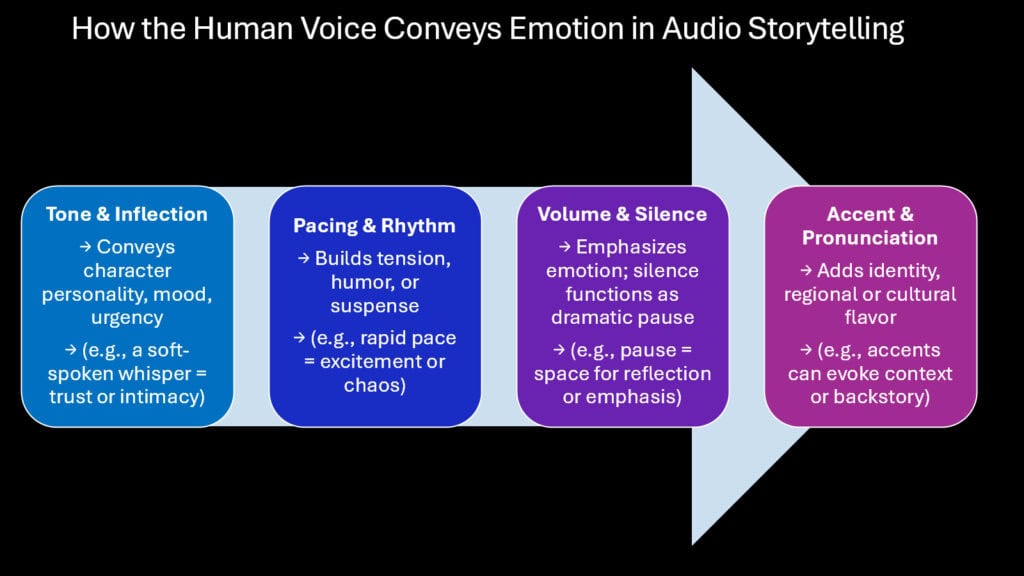
Human voice carries emotional information that transcends words themselves. In audio storytelling, vocal delivery becomes an artistic medium capable of painting complex emotional landscapes within the listener’s imagination. Tone, rhythm, pace, and silence work together to create rich internal imagery without requiring visual components.
A skilled narrator uses vocal modulation to suggest character emotions, environmental atmospheres, and narrative tensions. Rising intonation can indicate excitement or uncertainty, while falling tones suggest resolution or sadness. Pauses create suspense or reflection, allowing listeners’ imaginations to fill temporal spaces with anticipation or contemplation.
The phenomenon of vocal embodiment allows listeners to feel physical sensations through audio delivery. A whispered confession creates intimacy, while a shouted warning generates urgency. These vocal cues trigger corresponding emotional and physical responses in listeners, making the imaginative experience viscerally real.
Audio storytelling also exploits the human tendency toward vocal empathy. When we hear emotional expression in someone’s voice, mirror neurons activate corresponding emotional states within ourselves. This neurological response means audio storytellers can directly influence listeners’ emotional landscapes, guiding imaginative experiences through vocal artistry.
Regional accents, speech patterns, and linguistic choices further enhance this emotional palette. A narrator’s accent can instantly transport listeners to specific geographical or cultural contexts, while speech rhythm can suggest character personality or narrative mood. These vocal elements provide rich material for imaginative construction.
Table 3: Vocal Elements and Their Emotional Functions
| Vocal Element | Emotional Function | Imaginative Response |
|---|---|---|
| Tone Variation | Conveys character emotions | Triggers empathetic visualization |
| Rhythm and Pace | Establishes narrative mood | Creates temporal imagination |
| Strategic Silence | Builds suspense and reflection | Encourages gap-filling activity |
| Accent and Dialect | Provides cultural context | Enhances setting visualization |
| Volume Dynamics | Suggests proximity and intensity | Influences spatial imagination |
3. Imagined Realities: How Audio Storytelling Shapes Mental Landscapes
Cognitive poetics provides a framework for understanding how audio storytelling activates mental imagery and conceptual blending within listeners’ minds. This literary theory examines the cognitive processes underlying imaginative engagement with narrative texts, revealing how human brains construct meaning through pattern recognition, schema activation, and creative synthesis.
Mental imagery formation represents a core component of cognitive poetics. When audio storytellers describe environments, characters, or actions, listeners automatically generate corresponding mental pictures based on their cognitive schemas. These internal representations combine stored memories with new narrative information, creating rich imaginative landscapes that feel vivid and real.
Schema theory explains how listeners organize and interpret audio narrative information. Cognitive schemas function as mental structures that assist in processing new experiences by connecting them to known patterns. Audio storytelling triggers relevant schemas through verbal cues, allowing listeners to rapidly construct complex mental models of story worlds.
Conceptual blending occurs when listeners merge different cognitive domains to create new imaginative possibilities. Audio storytelling facilitates this process by presenting unexpected combinations of familiar elements, encouraging listeners to creatively synthesize disparate concepts into coherent narrative experiences.
The temporal nature of audio delivery enhances these cognitive processes. Unlike static visual media, audio storytelling unfolds through time, allowing listeners to gradually build and refine their mental models as new information emerges. This progressive construction creates dynamic imaginative experiences that evolve throughout the listening process.
Modern neuroscience research supports these cognitive poetics insights, revealing how audio narrative processing activates multiple brain regions associated with language comprehension, memory retrieval, and sensory imagination. Brain imaging studies show that listening to detailed descriptions triggers activity in corresponding sensory cortices, suggesting that imagination involves genuine neurological simulation of described experiences.
Table 4: Cognitive Processes in Audio Storytelling
| Cognitive Process | Audio Storytelling Trigger | Mental Landscape Result |
|---|---|---|
| Mental Imagery Formation | Descriptive language cues | Vivid internal visualizations |
| Schema Activation | Familiar narrative patterns | Rapid world-building comprehension |
| Conceptual Blending | Unexpected element combinations | Creative imaginative synthesis |
| Progressive Construction | Temporal information delivery | Dynamic evolving mental models |
| Sensory Simulation | Detailed sensory descriptions | Embodied imaginative experiences |
4. From Silence to Soundscapes: The Sonic Worldbuilding of Audio Storytelling
Audio storytelling extends far beyond voice alone, incorporating ambient sounds, Foley effects, and musical elements to create immersive sonic environments that transport listeners into fully realized imaginative worlds. This sonic worldbuilding represents one of audio storytelling’s most distinctive capabilities, allowing creators to construct three-dimensional auditory spaces within listeners’ minds.
Ambient soundscapes establish environmental context through subtle audio cues. The gentle rustling of leaves suggests outdoor settings, while echoing footsteps indicate indoor spaces with hard surfaces. These background sounds operate below conscious awareness, automatically triggering appropriate spatial schemas and helping listeners visualize story environments without explicit description.
Foley effects add realistic detail to narrative action, making imaginative experiences feel tangible and immediate. The creak of a door, the splash of water, or the crack of breaking wood provides sensory information that enhances mental visualization. Skilled audio producers understand that authentic-sounding effects often matter more than perfect accuracy, as listeners’ imaginations readily accept convincing audio representations.
Musical elements serve multiple functions in audio storytelling, from establishing emotional mood to signaling narrative transitions. Leitmotifs can represent specific characters or themes, while musical dynamics can guide emotional responses and imaginative focus. Music also helps structure the listening experience, providing auditory punctuation that organizes narrative flow.
The layering of multiple sonic elements creates complex auditory environments that rival visual media in their immersive power. Contemporary audio dramas like “The Magnus Archives” demonstrate sophisticated sonic worldbuilding, using subtle audio design to create unsettling atmospheres that enhance narrative tension and imaginative engagement.
Spatial audio technologies further enhance this sonic worldbuilding potential. Binaural recording and 3D audio processing can create convincing illusions of three-dimensional space, allowing listeners to feel positioned within story environments. These technical innovations expand audio storytelling’s imaginative possibilities while maintaining its essential accessibility.
Table 5: Sonic Elements in Audio Worldbuilding
| Sonic Element | Worldbuilding Function | Imaginative Enhancement |
|---|---|---|
| Ambient Soundscapes | Establishes environmental context | Triggers spatial visualization |
| Foley Effects | Provides realistic action details | Enhances sensory imagination |
| Musical Scoring | Guides emotional response | Deepens emotional engagement |
| Sound Layering | Creates complex auditory environments | Builds immersive experiences |
| Spatial Audio | Simulates three-dimensional positioning | Enhances presence and immersion |
5. Fragmented Narratives and Active Listening in Audio Storytelling
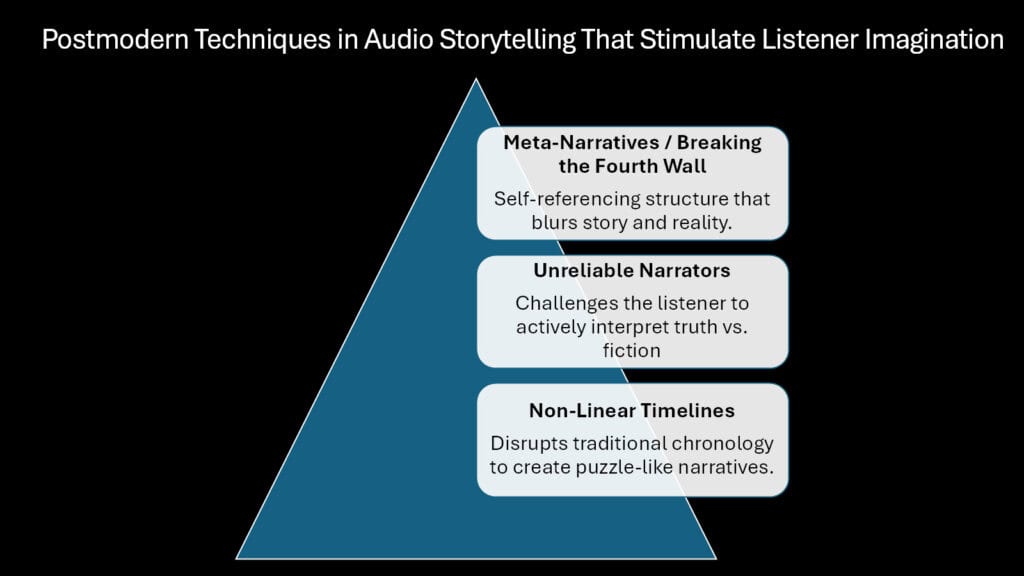
Postmodern narrative theory reveals how fragmented storytelling structures and unreliable narrators can enhance imaginative engagement by demanding active interpretive participation from listeners. Audio storytelling particularly excels at employing these postmodern techniques, using the temporal nature of audio delivery to create complex narrative puzzles that listeners must actively solve.
Non-linear storytelling in audio format challenges traditional chronological expectations, presenting narrative fragments that listeners must mentally arrange into coherent patterns. Time jumps, flashbacks, and parallel storylines require active cognitive engagement as listeners track multiple narrative threads and construct overarching meaning from dispersed information.
Unreliable narrators exploit audio storytelling’s intimate delivery format to create compelling interpretive challenges. When listeners hear a story directly from a potentially biased or deceptive source, they must constantly evaluate narrative credibility while constructing their own understanding of events. This active skepticism enhances imaginative engagement by making listeners collaborative interpreters rather than passive recipients.
Stream-of-consciousness techniques work particularly well in audio format, as the temporal flow of speech naturally mimics the movement of thought. Audio storytellers can present fragmented memories, interrupted reflections, and associative leaps that mirror actual cognitive processes, inviting listeners to follow complex mental pathways.
Multiple perspective narratives gain added complexity in audio format through distinct vocal characterizations. When different narrators present conflicting versions of events, listeners must actively synthesize these perspectives while recognizing the subjective nature of narrative truth. This interpretive work deepens imaginative investment in the story world.
The podcast series “Serial” exemplifies postmodern audio storytelling, presenting a true-crime investigation through fragmented evidence and multiple perspectives. Listeners become active participants in evaluating evidence and constructing theories, demonstrating how fragmented narratives can enhance rather than hinder imaginative engagement.
Table 6: Postmodern Techniques in Audio Storytelling
| Postmodern Technique | Audio Implementation | Active Listening Requirement |
|---|---|---|
| Non-linear Structure | Time jumps and flashbacks | Mental chronology reconstruction |
| Unreliable Narration | Biased or deceptive storytellers | Credibility evaluation |
| Stream-of-consciousness | Fragmented thought patterns | Cognitive pathway following |
| Multiple Perspectives | Distinct vocal characterizations | Perspective synthesis |
| Fragmented Information | Dispersed narrative clues | Active pattern recognition |
6. Personalization and Presence: Audio Storytelling’s Intimate Connection
Audio storytelling creates uniquely intimate experiences through its personal delivery format and sophisticated temporal manipulation techniques. This intimacy enhances imaginative engagement by making listeners feel personally addressed and emotionally connected to narrative content. The use of flashbacks and flashforwards further intensifies this personal connection by mimicking natural memory processes.
The whispered quality of many audio narratives creates a confessional atmosphere where listeners feel like privileged confidants receiving secret information. This sense of exclusive access enhances emotional investment and imaginative participation, as listeners feel personally chosen to receive the story. Headphone listening amplifies this effect by creating a private auditory space where the narrator’s voice exists entirely within the listener’s head.
First-person narration in audio format achieves particular intimacy because listeners hear thoughts and emotions directly expressed through vocal delivery. Internal monologues become shared experiences as listeners access character consciousness through authentic vocal expression. This direct access to subjective experience creates powerful empathetic connections that fuel imaginative engagement.
Flashback techniques in audio storytelling mirror natural memory processes, allowing listeners to experience non-linear time in ways that feel psychologically authentic. When narrators shift between past and present, listeners follow these temporal movements through vocal cues and ambient changes, creating immersive experiences that replicate actual remembering.
Flashforward elements create anticipatory tension while demonstrating the complex temporal nature of human consciousness. By revealing future outcomes before explaining their origins, audio storytellers create interpretive gaps that listeners must imaginatively bridge. This technique transforms listeners into active temporal navigators within the story world.
Contemporary audio storytelling platforms enable unprecedented personalization through algorithmic recommendations and interactive elements. Listeners can choose their own narrative paths or receive customized content based on previous preferences, creating individualized imaginative experiences that respond to personal interests and emotional needs.
Table 7: Intimacy Techniques in Audio Storytelling
| Intimacy Technique | Personal Connection Method | Imaginative Enhancement |
|---|---|---|
| Whispered Delivery | Creates confessional atmosphere | Increases emotional investment |
| First-person Narration | Provides direct consciousness access | Enhances empathetic engagement |
| Flashback Integration | Mirrors natural memory processes | Creates authentic temporal experience |
| Flashforward Anticipation | Generates interpretive tension | Encourages active gap-filling |
| Algorithmic Personalization | Customizes content to preferences | Tailors imaginative experiences |
Conclusion: Why Audio Storytelling Will Shape the Future of Imaginative Media
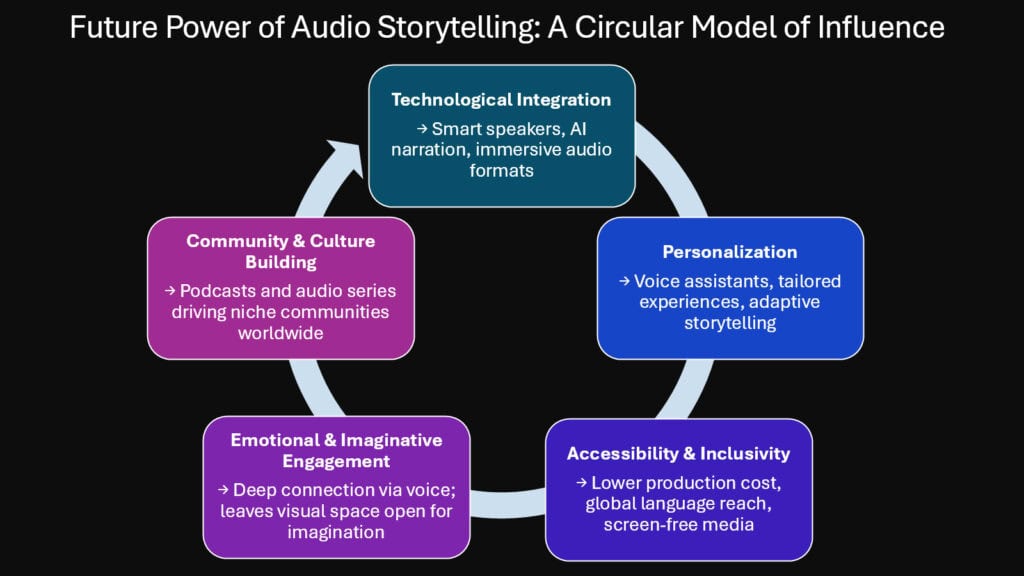
Audio storytelling’s unique capacity to fuel imagination positions it as an increasingly vital medium in our visually saturated digital landscape. While other media formats compete for attention through spectacular visuals and complex interactions, audio storytelling offers something irreplaceable: the invitation to actively participate in creating the narrative experience through personal imagination.
The six approaches explored in this analysis demonstrate audio storytelling’s multifaceted power. Reader-response engagement transforms listeners into co-creators, while vocal artistry provides emotional depth without visual constraints. Cognitive poetics reveals how audio narratives trigger sophisticated mental processes, and sonic worldbuilding creates immersive environments through sound alone. Postmodern fragmentation challenges listeners to actively construct meaning, while intimate personalization makes each listening experience uniquely individual.
As artificial intelligence and virtual reality technologies advance, audio storytelling’s human-centered approach becomes increasingly precious. The format’s emphasis on imagination over predetermined imagery offers a counterbalance to media environments that leave little room for personal interpretation. Audio storytelling preserves and celebrates the human capacity for creative visualization and emotional empathy.
Future developments in spatial audio, interactive narratives, and personalized content delivery will likely expand audio storytelling’s imaginative possibilities while maintaining its essential accessibility. The format’s compatibility with multitasking lifestyles ensures continued relevance in busy contemporary cultures, while its minimal technological requirements make it globally accessible.
Audio storytelling will continue shaping imaginative media by demonstrating that the most powerful stories often emerge from the collaboration between storyteller and listener. In an age of passive consumption, audio storytelling demands active participation, ensuring that each listening experience becomes a unique creative act.
Table 8: Future Developments in Audio Storytelling
| Future Development | Imaginative Potential | Cultural Impact |
|---|---|---|
| Spatial Audio Technology | Enhanced environmental immersion | Deeper narrative presence |
| Interactive Narrative Paths | Personalized story experiences | Individual creative agency |
| AI-Assisted Personalization | Customized emotional resonance | Targeted imaginative engagement |
| Global Accessibility Expansion | Diverse cultural perspectives | Enriched collective imagination |
| Multitasking Integration | Seamless lifestyle incorporation | Sustained imaginative practice |

